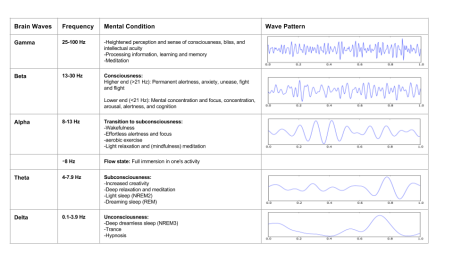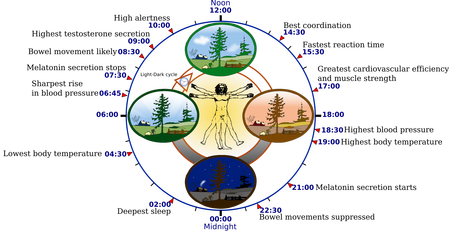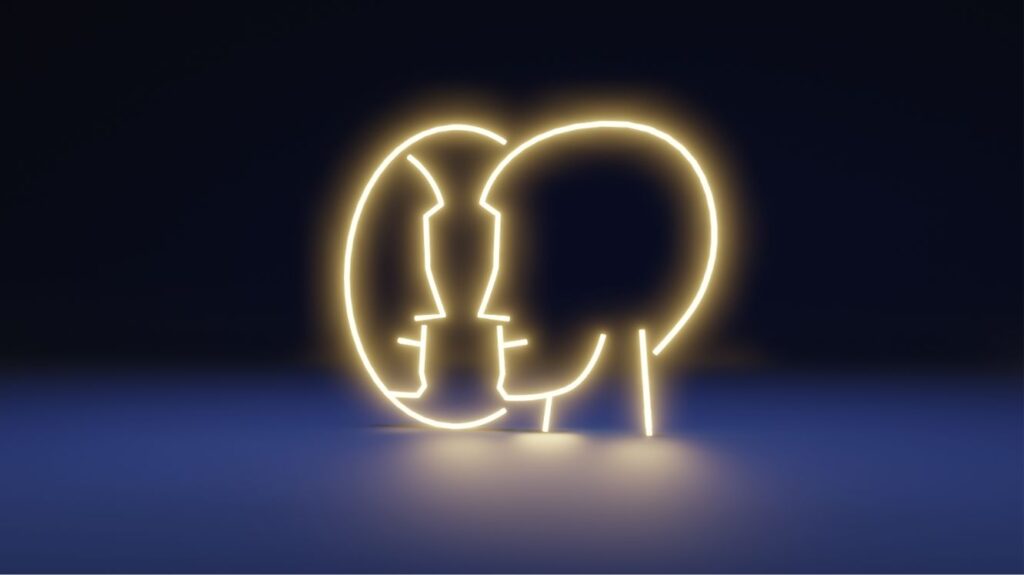What Happens During Sleep
Similar to your smartphone, wireless router or microwave also your brain is electrically active and emits electromagnetic waves too. The frequencies of these brain waves can be measured as cycles per minute (Hertz) with an electroencephalogram (EEG). While your smartphone operates with several 100 MHz (1 MHz = 1 million Hz), your brain works with single Hz in the range from 0.5 to 100 Hz. The brains activity differs greatly depending on the mental state. It not only varies when you are awake but also during sleep.
The following graph illustrates the different brain wave patterns.

Images: Wikipedia
There are two main types of sleep, defined by characteristic brain wave patterns and the absence or presence of eye movement:
- Rapid-eye-movement (REM) sleep
- Non-rapid-eye-movement (NREM) sleep
REM sleep is characterized by random movement of the eyes, low muscle tone throughout the body, and the propensity to dream vividly. The brain activity (mainly alpha and beta waves) looks close to the one in a waking state. Although the eyes move rapidly, your legs and arms are essentially paralyzed as a result of signals from the brains that inhibit muscle activity.
NREM sleep is sleep not recognizable as REM sleep and consist of 3 stages: NREM1, NREM2 (NREM1 + NREM2 defined as light sleep) and NREM3 (defined as deep sleep).
NREM1 is the transition phase between wakefulness and sleep, in which the muscles are active, and the eyes roll slowly, opening and closing moderately. Muscle tone is reduced and most conscious awareness lost. The brain wave spectrum shifts from alpha to theta waves. In NREM2 muscular activity decreases further and conscious awareness disappears. Sleepers become harder to awaken. Present in this stage are theta waves interrupted by brief spikes in brain wave activity, so called sleep spindles and k-complexes. NREM3 is characterized by the presence of delta waves and thought to be the most restful form of sleep. in this stage, the sleeper is the least responsive to environmental stimuli. Parasomnias such as night terrors, bedwetting, sleepwalking, teeth grinding or sleep talking occur in this stage.
The normal order of the sleep stages is: NREM1 → NREM2 → NREM3 → NREM2 → REM. In other words: At sleep you are cycling between deep sleep and REM sleep with light sleep always in between. That is why you spend most of your sleep time in light sleep. Usually you experience 4 to 5 of those cycles each night, each cycle takes around 90 minutes.
| Stage | NREM1 | NREM2 | NREM3 | REM |
| Phase | Light sleep | Light sleep | Deep sleep | REM sleep |
| Brain waves | Alpha to theta | Theta | Delta | Alpha & beta |
| Frequency | 8-13 to 4-7.9 Hz | 4–7.9 Hz | 0.1-3.9 Hz | 8-13 to 13-30 Hz |
| Sleep time % | 5-10% | 45–55% | 15–25% | 20–25% |
| 1 cycle ∼90 min | NREM1 → NREM2 → NREM3 → NREM2 → REM |
How does our sleep/wake cycle work?
All live on earth evolved under a night and day cycle. Selective pressure forced the organisms to develop mechanisms (internal clock) which enabled them to anticipate when it is going to be morning to time their activity and sleep accordingly. Diurnal (day active) animals had to ensure that they to wake up at sunrise to gather food throughout the day and be back in their cave at night. In order to survive it was tremendously important to know when to be prepared for physical
Every single organism and every cell the human body follows a circadian rhythm. The circadian rhythm is a biological cycle of ∼24 hours and regulates our sleep-wake cycle. You can think of it as an internal clock for physiological processes such as hormone production and central nervous system activity. It governs when a cell is most metabolically active, when hormones are released or when repair processes are activated. As you can see below your body is best prepared for certain activities at certain hours.

This internal clock is entrained by external cues (called zeitgebers) such as light [2], food, temperature or exercise [2] to be tuned to actual environmental conditions.
For ideal sleep – a precondition for optimal health and performance – it is essential to synchronize your daily agenda with your biorhythm.
Disruption of the clock has been associated with human cancers [2], metabolic diseases [2,3,4] and aging [2,3].
You can read Part IV here.
